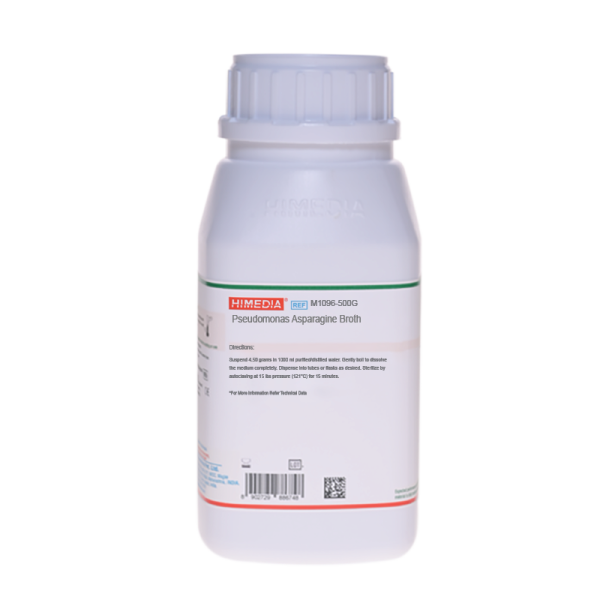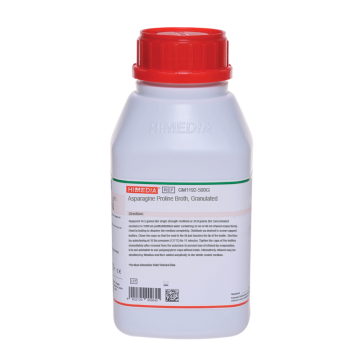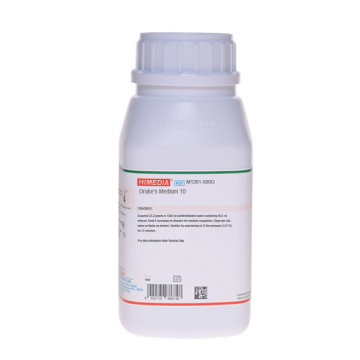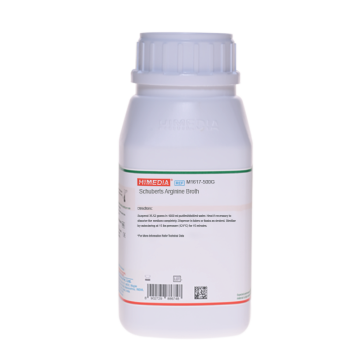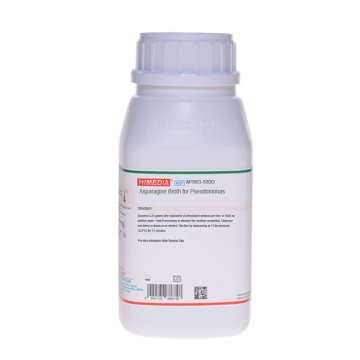 Your enquiry has been submitted
Your enquiry has been submitted
Pseudomonas Asparagine Broth
Pseudomonas aeruginosa#CC293D
Intended Use:
Recommended for the presumptive determination of Pseudomonas aeruginosa from recreational or natural water as per APHA.
Composition**
| Ingredients | g/L |
|---|---|
| DL-Asparagine | 3.000 |
| Dipotassium hydrogen phosphate | 1.000 |
| Magnesium sulphate | 0.500 |
Final pH (at 25°C): 7.0±0.2
**Formula adjusted, standardized to suit performance parameters
Directions
Suspend 4.5 grams in 1000 ml purified/distilled water. Gently boil to dissolve the medium completely. Sterilize by autoclaving at 15 lbs pressure (121°C) for 15 minutes. Mix well and dispense as desired.
Principle And Interpretation
Recreational water like from swimming pool is a body of water in a holding structure. Microorganisms of concern are those causing infections of ear, skin and upper respiratory tract etc. Pseudomonas aeruginosa is one of those organisms which account for a large percentage of swimming pool associated illness. Asparagine Medium is recommended for the microbiological analysis of water. Pseudomonas Aspargine Broth is an excellent enrichment medium for P. aeruginosa, since it is composed of a mineral base and the only carbon source is asparagine. It is also used in the multiple-tube technique for microbiological analysis of recreational waters. Pseudomonas Asparagine Broth is formulated as recommended by APHA (1) for presumptive detection of P. aeruginosa from recreational or natural waters. Pseudomonas Asparagine Broth medium is a relatively simple medium containing an amino acid DL- asparagine and two salts dipotassium phosphate and magnesium sulphate. Asparagine is the amino acid and carbon source while phosphate and sulphate provide the ions for the growth of P. aeruginosa. Dipotassium phosphate also helps in maintaining the buffering conditions of the medium. This medium is only a presumptive medium for P. aeruginosa, and further confirmatory tests are necessary for the identification.
Type of specimen
Water samples
Specimen Collection and Handling
For five tubes multiple tube test, use 10 ml of single strength Aspargine Broth for inocula of 1 ml or less and 10 ml double strength Aspargine Broth for 10 ml inocula. For swimming pools, higher dilutions may be necessary. Incubate inoculated tubes at 35-37°C. After 24 hours and again after 48 hours of incubation examine tubes under long water ultraviolet light in a darkened room. Production of a green fluorescent pigment constitutes a positive presumptive test. Confirmation is performed by subculturing a loop from each tube in Acetamide Medium (M148). Development of purple colour within 24-36 hours of incubation at 35-37°C is a positive confirmed test for P. aeruginosa. After use, contaminated materials must be sterilized by autoclaving before discarding.
Warning and Precautions
Read the label before opening the container. Wear protective gloves/protective clothing/eye protection/ face protection. Follow good microbiological lab practices while handling specimens and culture. Standard precautions as per established guidelines should be followed while handling specimens. Safety guidelines may be referred in individual safety data sheets.
Limitations
- Some strains may show poor growth due to nutritional variations.
- For further confirmation biochemical and serological test must be carried out.
Performance and Evaluation
Performance of the medium is expected when used as per the direction on the label within the expiry period when stored at recommended temperature.
Quality Control
Appearance White to cream homogeneous free flowing powder
Colour and Clarity of prepared medium Colourless clear solution with slight precipitate forms in tubes.
Reaction Reaction of 0.45% w/v aqueous solution at 25°C. pH : 7.0±0.2
pH 6.80-7.20
Cultural Response Cultural characteristics observed after an incubation at 35-37°C for 20 - 24 hours.
| Organism | Inoculum (CFU) | Growth |
|---|---|---|
| Pseudomonas aeruginosa ATCC 27853 (00025*) | 50-100 | luxuriant |
Key: (*) Corresponding WDCM numbers.
Storage and Shelf Life
Store between 10-30°C in a tightly closed container and the prepared medium at 15-25°C. Use before expiry date on the label. On opening, product should be properly stored dry, after tightly capping the bottle in order to prevent lump formation due to the hygroscopic nature of the product. Improper storage of the product may lead to lump formation. Store in dry ventilated area protected from extremes of temperature and sources of ignition. Seal the container tightly after use. Product performance is best if used within stated expiry period.
Disposal
User must ensure safe disposal by autoclaving and/or incineration of used or unusable preparations of this product. Follow established laboratory procedures in disposing of infectious materials and material that comes into contact with sample must be decontaminated and disposed of in accordance with current laboratory techniques (2,3).
Reference
- Lipps WC, Braun-Howland EB, Baxter TE, eds. Standard methods for the Examination of Water and Wastewater, 24th ed. Washington DC:APHA Press; 2023.
- Isenberg, H.D. Clinical Microbiology Procedures Handbook 2nd Edition.
- Jorgensen, J.H., Pfaller, M.A., Carroll, K.C., Funke, G., Landry, M.L., Richter, S.S and Warnock., D.W. (2015) Manual of Clinical Microbiology, 11th Edition. Vol. 1.
| Product Name | Pseudomonas Asparagine Broth |
|---|---|
| SKU | M1096 |
| Product Type | Regular |
| Physical Form | Powder |
| Origin | Chemically defined |
| Packaging type | HDPE |
| References | 1. Eaton A. D., Clesceri L. S. and Greenberg A W., (Eds.), 2005, Standard Methods for the Examination of Water andWastewater, 21st Ed., APHA, Washington, D.C. |
| Customized Product Available | No |



